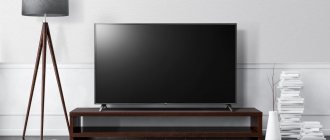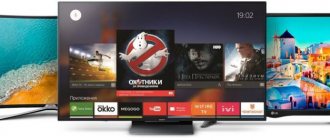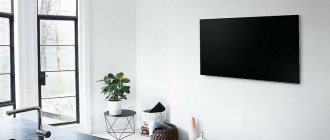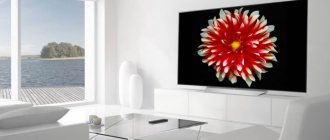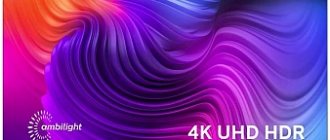Every year, manufacturers update their TV lines, adding updated processors, picture/sound improvement technologies, and functions. Today, it is extremely difficult to understand all the segments of even one specific brand, not to mention choosing the appropriate model specifically for your case. Taking this into account, we have compiled a ranking of the best TVs of 2021, collecting the leaders (in our opinion) in different sizes. To make it easier to navigate the lines, we suggest conditionally dividing all solutions, regardless of brand, into the following types:
- HD (1280×720) are the most budget models, the resolution of which justifies the use of a small panel (up to 32 inches). On larger screens, detail will be poor;
- FullHD (1920×1080) is still a relevant resolution for TVs, but is gradually becoming a thing of the past compared to more detailed analogues;
- 4K (3840×2160) is the most current resolution, attracting with detail 4 times higher than the previous FHD format.
- 8K (7680x4320) is a relatively new format, the resolution of which is supported only by some streaming services. In other cases, you have to resort to using different technologies for scaling the image in order to achieve a suitable image. Over time, as in the case of 4K, many hosting sites and services will adapt to this format; there are already the necessary codecs for quickly transmitting fairly heavy images.
As for the technologies that are used to produce modern TVs, we note the following types:
- LED LCD is the best option for the budget and middle class;
- OLED is a premium segment, attractive due to the presence of independent organic light-emitting diodes. The technology argues for a wider viewing angle, a high level of color rendition, and clarity.
- QLED technology is supposedly built on quantum dots, which enhance color and brightness, but at the moment this Samsung development has not yet been completed, since nanoparticles have to be stimulated by an additional backlight layer. This implies additional costs in terms of energy, in addition, the solutions of this South Korean manufacturer are more massive. However, in the daytime, models using this technology are brighter, and this is a fact.
Today, against the backdrop of processors, various technologies and AI, it is difficult to focus on the matrix used, but nevertheless:
- TN are the fastest, so they are used in the production of gaming monitors;
- VA is somewhere between IPS and TN, and has a wider viewing angle, good color rendition compared to the latest solutions;
- IPS is the best matrix for TVs, due to its support for a wide viewing angle and excellent color reproduction. There are many varieties of the Nano Cell (LG) type with an additional layer of nanoparticles, but the essence is the same.
The best TVs from 32″ to 37″
In this category there are mainly inexpensive models designed for use in the kitchen or small living room. As practice shows, such models have HD or FullHD resolution.
Important! There are not as many models with Smart TV support in this category as we would like. At the same time, you have to overpay for Internet access. You can find more flagship solutions in our separate rating of TVs for the kitchen.
We have collected popular and current solutions in FHD resolution, understanding that this format is the most relevant and in demand today among both ordinary users and content creators. All presented models have SMART TV, since many users only need tuners with cable or satellite broadcasting for use in the kitchen.
Philips 32PFS5605
The Top 20 TVs of this year opens with an inexpensive 32-inch model without a SMART TV, but with a good level of brightness and image saturation. The resolution of the Philips 32PFS5605 is 1920 by 1080 pixels. The LED panel has good built-in speakers with a power of 16 W. Clear sound is due to Clear Sound support, which does an excellent job of optimizing vocals. Users respond positively to the strength of the case and the light weight of the equipment - only 4 kilograms. In addition, the TV consumes only 24 W, which indicates efficiency in terms of electricity and network load. There is a TV program, weather forecast and news.
Pros:
- small body;
- clear picture;
- good sound;
- simple controls.
Minuses:
- no Smart TV.
Polarline 32PL53TC-SM
Another inexpensive but good TV for the kitchen with SMART TV. The liquid crystal panel attracts with good backlighting and a resolution of 1920 by 1080 pixels. Direct LED backlighting is provided, which is rarely seen in an entry-level class. TimeShift support has been implemented, which indicates the possibility of recording TV programs and other content on removable storage media. The power of the speaker system is 16 W. It is worth highlighting the support for an excellent external interface, including HDMI and VGA. There is a power supply that is included in the MainBoard. However, the screen is very fragile. It can even be broken by a child’s toy, so it’s worth taking this factor into account.
Pros:
- excellent lighting;
- TimeShift support;
- low cost;
- good speakers.
Minuses:
- It's not yet a very popular brand.
Samsung UE32T5300AU
This model is part of the Crystal UHD 4K line, which has a relatively affordable price compared to other segments of the brand. At the same time, the 32-inch Samsung TV UE32T5300AU series boasts Full HD resolution, support for extended dynamic range HDR and SMART TV. Control can be carried out directly from Apple gadgets. Based on the design, you can understand that the device is more expensive than competitors presented earlier. Actually, this also manifests itself in terms of proprietary technologies. Good immersion is guaranteed by PurColor technology, which improves color reproduction. There is Ultra Clean View, which means that distortion is eliminated. In addition, the manufacturer took care of Contrast Enhancer technology, which controls the optimal contrast level. However, if the panel is exposed to direct sunlight, glare cannot be avoided.
Pros:
- thin body;
- contrast and brightness;
- simple controls;
- clear picture.
Minuses:
- glare in the sun.
LG 32LM6390
The former leader in the kitchen TV segment is the LG 32LM6390 model with support for Direct LED and an excellent IPS matrix. A really clear, rich picture is also due to the presence of HDR10. The resolution is 1920x1080 pixels, there is a SMART TV. The small device runs on the webOS 4.5 operating system, which already has AI. This is reflected in the ease of control, there is Google Assistant. The low cost is also due to the presence of good speakers with a total power of 10 W. VESA mounts (200 by 200) are provided for quick installation. The design supports 3 HDMI interfaces, there are 2 USB ports. The kit includes a Magic Remote.
Pros:
- number of interfaces;
- Google Assistant support;
- proprietary OS;
- there is support for HDR10;
- viewing angle and brightness.
Minuses:
- not detected.
QLED Samsung The Frame QE32LS03TBK
The best 32-inch TV of 2021 is the Samsung The Frame QE32LS03TBK model based on QLED technology. As you understand, we are talking about the premium segment, which is reflected in the price of the equipment, as well as in terms of functionality. A Smart platform is used with support for a built-in browser and teletext. I am pleased with the quality of the matte coating, the Color Volume with Quantum Dot system. Unlike analogues, this device has 20 W speakers. Due to the high brightness, clarity and viewing angle, this technique is often used in small bedrooms. Support for a wide range of content formats has been implemented, many interfaces and technologies have been implemented: from the “Picture” mode to Time Shift.
Pros:
- expensive matrix;
- sound power;
- scope of application;
- resolution scaling.
Minuses:
- high price.
6LG OLED55C7V
— diagonal 54.6 inches (139 cm);
— UltraHD resolution, 3840*2160; — OLED screen; — brightness 720 cd/m2; — refresh rate 120 Hz; — Smart TV available (webOS), HDR; — power consumption 195 W; - weight 17.3 kg (with stand - 19.2 kg); — price about $1800. And here is a TV with an OLED screen. There are still only a few of these and, as you understand, they are not cheap. A large, clear and contrasting screen is, of course, the strong point of the model, but the TV also impresses with its cool sound. It uses 4 speakers (instead of the usual two), there is a subwoofer and surround sound. As for additional features, there is everything that a modern TV can include: HDR, SmartTV, and 24p True Cinema. The model received 4 HDMI outputs, 3 USB outputs and a lot of other connectors. If your budget allows, this TV is definitely worth considering buying.
The best TVs from 43 to 50 inches
This category contains mid-price models with support for 4K resolution. It’s worth noting right away that the new generation of LG based on the NanoCell series has a more attractive price/quality ratio, in our opinion, than its competitors. The fact is that Samsung in this standard size do not have a very high refresh rate, all other things being equal, and their new models are more expensive. In turn, the more affordable Xiaomi is much simpler in terms of processor and technology for improving picture/sound. For this reason, the products of the first South Korean brand in this category are in greatest demand in Europe.
Xiaomi Mi TV 4A
The 43″ model from Xiaomi Mi TV 4A series joins the rating of this year’s TVs. Despite the reasonable cost, the Chinese manufacturer took care of supporting AI and PatchWall technology. The model with support for FullHD resolution and SMART TV has a good Direct LED backlight, and the viewing angle of the LCD matrix reaches 178°. The product description states support for HDR10 and HLG, which indicates a high contrast ratio. The new Amlogic T962 ARM processor with a core frequency of 1.5 GHz is responsible for the performance. The chip works in conjunction with 2 gigabytes of RAM, which indicates stability and good response. There is support for DTS HD audio decoding, and the audio power is 12 W.
Pros:
- good processor;
- HDR10 declared;
- PatchWall technology;
- excellent tuner.
Minuses:
- average color rendering.
Philips 43PUS7505
Another good quality TV with a diagonal of 43 inches. The Philips 43PUS7505 model supports really working HDR, there is Dolby Atmos technology, which is clear from the surround sound. The bright 4K picture with HDR10+ is complemented by a good Philips P5 series processor, which responds responsively to commands and guarantees stability over time. Of course, there is no question of scaling the picture, since the model is not the newest, and it is far from competitors from South Korean manufacturers. But for a bedroom at this price, this device is quite suitable. Smart TV involves connecting to YouTube, Netflix and other services. Users respond positively to the menu with icons. The SAPHI operating system is used.
Pros:
- bright picture;
- 4K resolution;
- decent sound;
- convenient system
Minuses:
- few technologies compared to analogues.
NanoCell LG 49SM8000
A definitely good LG TV in the 49-inch category is the 49SM8000 model based on a NanoCell matrix with an additional layer of nanoparticles. In terms of color rendering quality and detail, this technology is as close as possible to the premium sector of OLED models. The manufacturer took care of the presence of a powerful 4-core processor. Features 4K active wide range HDR with DTS Virtual:X™. In addition, this model supports AirPlay 2. It has a good viewing angle, surround sound, zoom support, and an optimal contrast ratio. Among the disadvantages, we can note the presence of newer models on sale, which operate on the basis of more advanced processors, guaranteeing more effective immersion in what is happening on the screen.
Pros:
- good brightness;
- AirPlay 2 support;
- good contrast;
- color rendering level.
Minuses:
- not the new generation.
Samsung UE50TU7097U
If you're looking for a crisp 50-inch 4K TV with Smart TV, we also recommend taking a look at the Samsung UE50TU7097U. It is a balanced product with an aspect ratio of 16 by 9 and can be mounted on a stand or mounted into a wall. A good processor and a high-quality matrix guarantee a stable, fairly clear picture. At the same time, Smart TV and support for the Wi-Fi module open up a wide range of multimedia capabilities. It has its own tuner, which allows you to use different TV channels without purchasing additional equipment. Separately, it should be noted the sound quality, which is due to the use of good stereo speakers and Dolby Digital Plus technology. It is worth adding that the device runs on a VA matrix and supports gaming mode. The update frequency is twice as high as that of competitors.
Pros:
- balanced model;
- refresh rate 100 Hz;
- Game Mode;
- high-quality sound;
- durable stand.
Minuses:
- not found.
NanoCell LG 50NANO796NF
The best 49-inch TV of 2021 is the LG 50NANO796NF model, built on NanoCell technology with 4K resolution, excellent color reproduction and SMART TV technology. The advantages of this model include an effective chip that eliminates noise and allows for better contrast. LEDs are not afraid of fading over time. Among other things, the manufacturer took care of high-quality sound and eye protection for users - the device meets the requirements of the International Electrotechnical Commission. At the same time, the entire NanoCell line guarantees an increased level of contrast and black color display. The video sequence has become more optimized.
Pros:
- quality black color;
- contrast level;
- good brightness;
- good sound.
Minuses:
- No.
2LG 55UJ620V
— diagonal 48.5 inches (123 cm);
— UltraHD resolution, 3840*2160; — DirectLED screen; — viewing angle 178 degrees; — refresh rate 50 Hz; — Smart TV available (webOS), HDR; — power consumption 130 W; - weight 11.3 kg (with stand - 11.4 kg); — price about 610$. The model has an average diagonal and excellent resolution. Everything is fine with color reproduction, there is a Smart TV, HDR mode, viewing angles, as well as sound quality, are pleasing. Wi-Fi and Bluetooth modules are available, the model has 3 HDMI ports and 2 USB. For a device at this price, the parameters are excellent. Some may be upset by the lack of a headphone output, but the problem can be solved by purchasing an adapter. There are minor complaints about the control panel and legs, but everything is uncritical here. Smart TV sometimes freezes, but this is, unfortunately, a common problem.
The best TVs from 55″ to 65″
This section presents premium solutions with a large screen and support for Upscaling technology. The option is responsible for scaling the image to 4K or 8K, depending on the supported resolution. This is an important technology, since today not many streaming services and hosting are ready to offer such a clear and detailed picture. However, there is reason to believe that in the near future we will gradually move away from the 4K format in favor of new solutions.
NanoCell LG 55NANO866
When considering premium 4K TVs, it’s hard to ignore the 55-inch model based on NanoCell technology, the 55NANO866 series. The flagship line has a refresh rate of 120 Hz, which indicates a smooth picture. Support for Upscaling technology up to 4K has been implemented, which allows you to scale images with a lower resolution for better viewing of content. HDR technology with improved brightness is provided. Really wide viewing angles, very smooth video even when watching dynamic sports programs, and FreeSync technology are attractive. This model can be controlled using voice assistants.
Pros:
- smooth video sequence;
- excellent brightness;
- upscaling to 4K;
- voice control.
Minuses:
- not available in this size.
Xiaomi Mi TV 4S 55 T2
This collection of TVs differs from the 4A line exclusively in their metal frame. The rest of the parameters are the same. As you understand, this 55-inch TV from Xiaomi complements our rating due to its excellent price/quality ratio, since we have already reviewed the more compact series, and discussed this obvious advantage. Among the shortcomings, we note 8-bit depth, which is clearly not enough to compete with the OLED and QLED matrices of South Korean competitors. However, for the indicated price you get a clear picture due to the 4K resolution, and a good level of brightness (around 300 cd/m²), which is considered a decent indicator. The total sound of the speakers is 20 W.
Pros:
- voice control;
- proprietary Mi Home application;
- good sound;
- low cost.
Minuses:
- 8-bit matrix.
LG OLED55CX
This model probably has the most beautiful picture among 55″ TVs with 4K resolution. The fact is that the LG OLED55CX line is built on a 10-bit matrix using OLED technology. This indicates excellent color depth, brightness levels and viewing angle. There is full support for HDR, and the α 9 Gen 3 processor allows you to improve content with mediocre images. It is also worth noting that this generation of TVs is perfect for the Xbox Series X and other consoles: it supports AMD FreeSync and NVIDIA G-Sync technologies and achieves fast response. The TV runs on the proprietary webOS 5.0 OS. In terms of acoustics, everything is also good: the total power of the speakers and subwoofers is 40 W, there is Dolby Atmos technology.
Pros:
- suitable for games;
- new generation chip;
- screen technology;
- fast response;
- sweep frequency.
Minuses:
- not found.
NanoCell LG 65NANO956
This model has the best price/quality ratio among other 8K TVs, which can be explained by its support for NanoCell technology. LG's OLED models are clearly more expensive, but it will be difficult to distinguish the difference in this case. The device supports the entire spectrum of RGB colors, and excellent brightness and contrast are guaranteed by an additional layer of IPS matrix nanoparticles. It’s worth adding that this line includes all the company’s most advanced technologies, including the new α9 III processor. The chip actually analyzes the content and selects the optimal sound and image parameters. In addition to complete immersion in the content, the simplicity of operating the equipment is attractive.
Pros:
- smart processor;
- picture quality;
- amazing sound;
- color rendering and viewing angle;
- simple controls.
Minuses:
- No.
QLED Samsung QE65Q70TAU
The best premium 65-inch TV on a QLED (quantum dot) matrix from Samsung is the QE65Q70TAU model, which attracts with 100% color gamut and excellent dual backlighting. With the model of this series, you can enjoy the brightest picture even in the daytime. In addition to HDR10+, this model supports Dual LED and high contrast levels. The processor uses Quantum 4K with support for scaling to the stated resolution. Separately, it is necessary to comment on the quality of the Smart Hub platform, which combines the highest quality and most popular content. You can control all devices connected to the device with one remote control.
Pros:
- Smart Hub base;
- powerful chip;
- upscaling to 4K;
- brightness during the daytime.
Minuses:
- high price tag.
1Samsung UE40MU6100U
— diagonal 40 inches (102 cm);
— UltraHD resolution, 3840*2160; — DirectLED screen; — viewing angle 178 degrees; — refresh rate 50 Hz; — Smart TV available (Tizen); — power consumption 130 W; - weight 7.7 kg (with stand - 8.7 kg); — price about $580. An excellent TV that will decorate your living room or bedroom. The model received excellent resolution, Smart TV function, wide viewing angles, three HDMI ports and two USB. In addition, TV programs can be recorded on a flash drive, there is voice control, digital noise reduction, and the TimeShift function allows you to stop the broadcast program at any time, and then continue watching it from the same moment where you left off. 24p True Cinema mode allows you to watch movies as they were shot (24 fps instead of the usual 25 fps). On the Internet, users share admiring reviews, finding fault only with the controls, but this is a matter of habit and taste.
The best premium TVs
Sony KD-75ZH8
In the category of TVs up to 80 inches, the premium TV from Sony Sony KD-75ZH8 definitely deserves attention, supporting the highest resolution today - 8K. That is 33 million pixels. Of course, the well-known manufacturer took care of upscaling the picture to 8K. Object-based Super Resolution technology, in turn, guarantees realistic textures. Improved contrast is due to the use of X-tended Dynamic Range™ technology. Super Bit Mapping HDR combines a chic combination of even subtle tones. With this model, you don’t have to worry about audio and video desynchronization, since the manufacturer took care of Acoustic Multi-Audio™. The model is capable of competing with home theaters and guarantees complete immersion, but you have to pay for such pleasure.
Pros:
- color rendition and clarity;
- sound quality;
- powerful chip;
- scaling the picture.
Minuses:
- overcharge.
OLED LG OLED77G1RLA
New for 2021, built on an OLED matrix. In addition to self-illuminating pixels, which are many times superior to LED panels in terms of picture quality, this model attracts with its gorgeous color gamut and AI processor. This may explain the high rating of the Intertek agency. A company from Britain tested the model and approved 100% color rendition. In fact, 100% coverage according to the DCI-P3 standard is a clear confirmation of this. The excellent sound deserves special attention, due to support for Dolby Atmos technology. In turn, Vision IQ technology. The latest technology is responsible for adjusting picture parameters based on the genre of content, as well as the surrounding environment.
Pros:
- improved algorithms;
- high color rendering;
- new model;
- Intertek expert assessment;
- great sound.
Minuses:
- not found.
QLED Samsung QE82Q800TAU
If you are interested in a large panel from Samsung, you may like the 82-inch model on a QLED matrix of the QE82Q800TAU series. The smart line is powered by a new chip that supports scaling and full immersion in content. The amazing surround sound is pleasing; the required tonality is distributed among the speakers based on content analysis and playback. Support for Q HDR 4000 has been implemented, opening up new possibilities for engineers to achieve the highest brightness. The manufacturer used its best practices and technology to create a powerful system. This rule also applies to SmartThings, with which you can control all devices and even household appliances. To accomplish this task, a universal remote control is included.
Pros:
- maximum brightness;
- SmartThings technology;
- smart processor;
- maximum clarity.
Minuses:
- No.
Sony XR-75Z9J
The ex-leader in our selection is the Sony XR-75Z9J series TV, the size of which is 75 inches. 8K resolution complements the amazing level of smoothness at 120 Hz. Obviously, this panel is excellent for both watching content, including fast-paced action films, and for playing games. The manufacturer has implemented the latest developments in this series, including technology to improve color, brightness, and extended dynamic range. Of course, the flagship Sony Cognitive Processor XR deserves special attention, which allows you to adapt to the environment and adjust content depending on the type of content. It is worth noting the presence of Google TV OS. The package includes a chic backlit remote control. I am pleased with the presence of voice control and the excellent appearance of the product.
Pros:
- 8K resolution;
- frequency 120 Hz;
- color improvement;
- flagship processor.
Minuses:
- line price.
LG OLED77Z1
The best premium TV of 2021 is the LG OLED77Z1 model, which measures 77 inches diagonally. By the “Z1” index in the name, you can understand that we are talking about the company’s flagship series of OLED TVs, which has the maximum amount of advanced technologies of the brand. In particular, this applies to the proprietary LG α 9 Gen 4 processor and 8K picture resolution. The frame refresh rate reaches 120 Hz. It's hard to capture the feeling of watching action movies or sports on this panel. The picture turns out really smooth. At the same time, the company's engineers took care of the implementation of HDR10 technology, as well as Dolby Vision. You can connect any gaming console and enjoy the process due to the support of AMD FreeSync technology. NVIDIA compatibility is also provided in the form of G-Sync technology. The total sound power is 60 W, and there is Dolby Atmos technology.
Pros:
- best technologies;
- smoothness of the picture;
- gaming compatibility;
- the most powerful chip;
- color improvement.
Minuses:
- high price.
7Samsung UE49MU6300U
— diagonal 49 inches (124 cm);
— UltraHD resolution, 3840*2160; — EdgeLED screen; — refresh rate 50 Hz; — Smart TV available (Tizen), HDR; — power consumption 180 W; - weight 12.3 kg (with stand - 13.5 kg); — price about $740. We understand that curved TVs have a lot of disadvantages, but if you don't often gather in front of the screen in large groups, and the futuristic look of such models is really appealing, then you will definitely like this TV. The screen here is very good in all respects, has a sufficient diagonal - the TV looks very decent. In addition, there is a Smart TV and an HDR mode, and it supports recording programs on a flash drive. Not without the TimeShift and 24p True Cinema functions. HDMI 3, USB – 2 outputs. The model turned out to be fast and produces an excellent picture.
Rating of the best TV manufacturers
In fact, the list of the best TV manufacturers can be very wide, because many brands focus on a certain price category and have their own technologies and goals. When compiling our subjective top, we took into account supply/demand and price/quality ratio.
- Philips . The manufacturer attracts with balanced TVs in the budget and middle class. Unlike its South Korean competitors, this brand pays a lot of attention to models with small sizes. This is confirmed by the use of the Philips Pixel Plus processor in 32-inch TVs. In our opinion, in the premium 4K TV category, it is more difficult for this brand to compete with other brands due to the dynamic development of others.
- Sony _ The products of this manufacturer have been seriously different in terms of price for quite a long time, not in a positive way for buyers. Indeed, Sony TVs deserve attention, since they always work on the basis of expensive technologies and matrices, they are distinguished by good factory calibration. That is, you do not need to study the settings for a long time, waste time choosing the optimal parameters, but from a price/quality point of view, things are not the best. In addition, South Korean brands have moved ahead in terms of AI and their processors.
- Xiaomi _ Another good TV manufacturer whose products attract attention out of the box with a bright picture. True, with calibration things are worse here than with Sony. The secret is that Xiaomi products on store shelves are initially set to maximum settings, which have to be adjusted. Often the stated data differs from the actual indicators. This can be seen in the refresh rate, HDR support, for example. However, the products of this brand are almost always worth their money.
- Samsung . Thanks to advanced intelligent functions, expensive QLED matrices and powerful processors, this manufacturer, in our opinion, deservedly takes second place in the list of the best TV brands. The downside is that not all new lines of the South Korean company are significantly better than previous generations. Often, new collections feature less striking characteristics at a higher price tag than before. The brand is likely moving towards larger screen sizes. However, Qled 4K, Qled 8K, UHD 4K are three types of TVs from the company that can compete with all modern brands.
- LG . The company holds more than 50% of the European market share in sales of 4K TVs. In the brand's assortment, among the new models, OLED TVs (premium segment) with the highest quality picture, NanoCell (IPS matrices with an additional layer of nanoparticles that filter color shades) deserve attention. The image is as close as possible to OLED. This line has no restrictions in terms of technology to improve sound and picture; the new models have powerful Alpha 7 Gen 3 chips. In the budget class, the company has excellent UHD TVs with a full range of Smart technologies.
Device Dimensions
Let's start with the simplest. There is an opinion that you should buy as big a TV as your budget allows. Previously, the standard was widespread that the distance from the audience to the screen should be 3-4 diagonals, later they started talking about 2-3 diagonals. Today it is believed that the optimal distance to the screen is a subjective concept, i.e. whoever is comfortable. How to find this optimal value, because a screen that is too small will not convey details, and a screen that is too large will force you to turn your head to see the entire scene?
The best way is to evaluate a TV in a store from the distance at which you will be watching it. So everything will immediately fall into place. And further. The purchase should look harmonious in the room and fit in the place prepared for it, so do not overdo it with the diagonal.
Typically, 32-55-inch TVs are used at home; smaller screens are sometimes placed in the kitchen, and larger ones in spacious living rooms.
Which TV is best to buy in 2021?
Unfortunately, it is quite difficult to collect all manufacturers in one place, so we base our rating on reviews, expert opinions and personal thoughts. So that the list does not look biased, we note that in the 4K format, South Korean manufacturers occupy more than 60% of the market in Europe, and these figures are growing. If you don’t know which TV to choose this year, we recommend that you first familiarize yourself with their list of models and lineups, since there are a lot of worthy solutions. Our conclusion:
- Inexpensive smart TV – Polarline 32PL53TC-SM 32″;
- The best budget model for the kitchen is LG 32LM6390;
- A good TV for gaming is Samsung UE50TU7097U 50″;
- Model with 4K in price and quality – NanoCell LG 55NANO866 55″;
- The best 4K TV is Samsung QE65Q70TAU 65″;
- Premium model with 8K – Samsung QE82Q800TAU 82″.
8LG 49SJ810V
— diagonal 49.5 inches (126 cm);
— UltraHD resolution, 3840*2160; — EdgeLED screen; — viewing angles 178 degrees, contrast 1500:1, brightness 350 cd/m2; — refresh rate 120 Hz; — Smart TV available (webOS), HDR; — power consumption 85 W; - weight 12.7 kg (with stand - 14.1 kg); — price about $930. A very, very interesting TV, in which everything is great, except the price. So, the pluses include the gorgeous 4K resolution and excellent sound. The manufacturer installed an audio system from Harman/Kardon and promises us rich surround sound. All the fashionable features, like Smart TV and HDR, are in place. There is a headphone jack and some interesting features. We also note the low power consumption and operating speed of SmartTV: webOS performs very well in this regard.
Smart TV and streaming services
Almost all modern TVs are smart TVs, meaning they can connect directly to your Wi-Fi to access built-in streaming services like Netflix or Amazon. These TVs are equipped with a built-in Smart TV add-on and have Wi-Fi for accessing services such as Netflix, YouTube, as well as for running other applications and games. Some of the latest models can even search for content across multiple streaming platforms, as well as stream live TV via cable or satellite.
These smart TVs run on operating systems and custom software interfaces, including Google Android TV, Amazon Fire Edition, and others with their own OS. Most of them offer all the necessary features and applications, and you will need to do some research to find out which of these interfaces is right for you. Beware of no-name TV OSes that clutter your smart TV with tons of pointless apps.
Most people like smart TVs because it means you don't have to buy an additional media streamer like a Roku Streaming Stick or Apple TV unless you prefer their interface or want to access services your TV doesn't support.
There is a common misconception that you can save money by buying a TV without smart features. In fact, any TV that doesn't have smart features (if you can even find them these days) is probably not worth buying, as it will be a budget model with mediocre picture quality.
Some people may be interested in TVs other than smart TVs because they are concerned about the privacy of their user data. If you're concerned about tracking your viewing habits, you can choose not to connect your TV to your home network, but keep in mind that you'll still need to connect periodically to download and manually install firmware updates that may improve your TV's performance, add features, or expand productivity.
